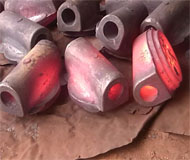How to Improve the Qualified Rate of Forging Products?
How to Improve the Qualified Rate of Forging Products?
Jul 22, 2020
As we know, some valve bodies (such as flanged ball valves) are traditionally produced by casting, but about 30% of them are unqualified and unstable in performance during processing and pressure test, which has a great impact on the use of valves.
In order to solve this problem, some manufacturers have broken through the traditional processing technique. The valve body is produced by forging, forging all parts of the forged valve integrally, forging the valve body by one-time hot die forging, and upsetting the round steel to preform a shape.
 After final forging and trimming, it can meet the requirements of the overall dimensions of the product. The product has excellent forging streamline, whose quality is well controlled. The internal metallographic structure is uniform and compact. The ultrasonic flaw detection meets the requirements by nearly 100%, and the appearance is beautiful.
After final forging and trimming, it can meet the requirements of the overall dimensions of the product. The product has excellent forging streamline, whose quality is well controlled. The internal metallographic structure is uniform and compact. The ultrasonic flaw detection meets the requirements by nearly 100%, and the appearance is beautiful.
The valve forging technology adopts a special billet making method, which makes forged parts better fill the cavity in the forming process, effectively prevents the defects such as insufficient material, and thus significantly improves the product qualification rate.
In order to solve this problem, some manufacturers have broken through the traditional processing technique. The valve body is produced by forging, forging all parts of the forged valve integrally, forging the valve body by one-time hot die forging, and upsetting the round steel to preform a shape.

The valve forging technology adopts a special billet making method, which makes forged parts better fill the cavity in the forming process, effectively prevents the defects such as insufficient material, and thus significantly improves the product qualification rate.
Next: Overview of Development in Forged Flange Industry
Previous: The Importance of Forging
News
About Us
Best Categories
Useful Links
